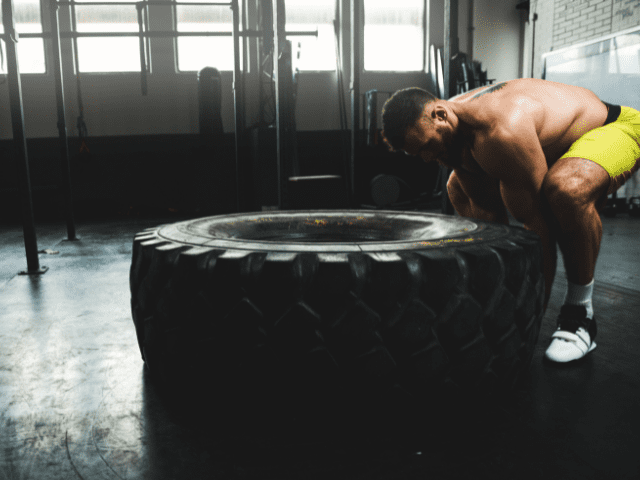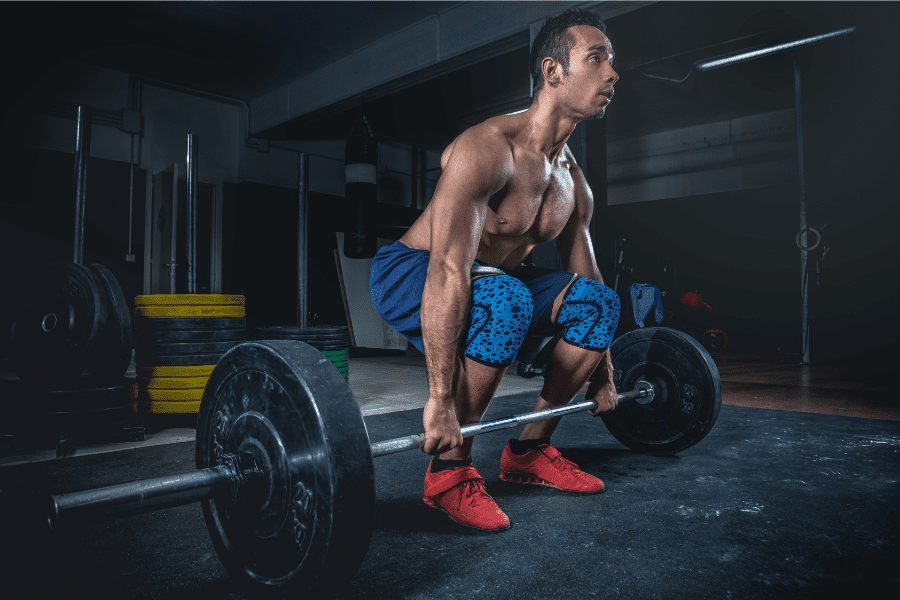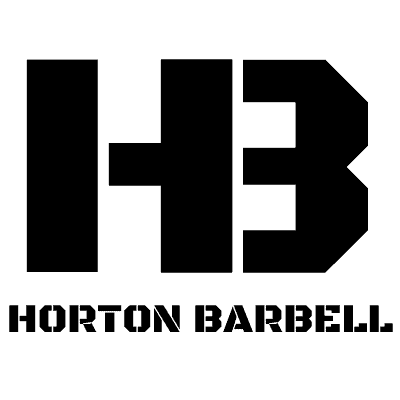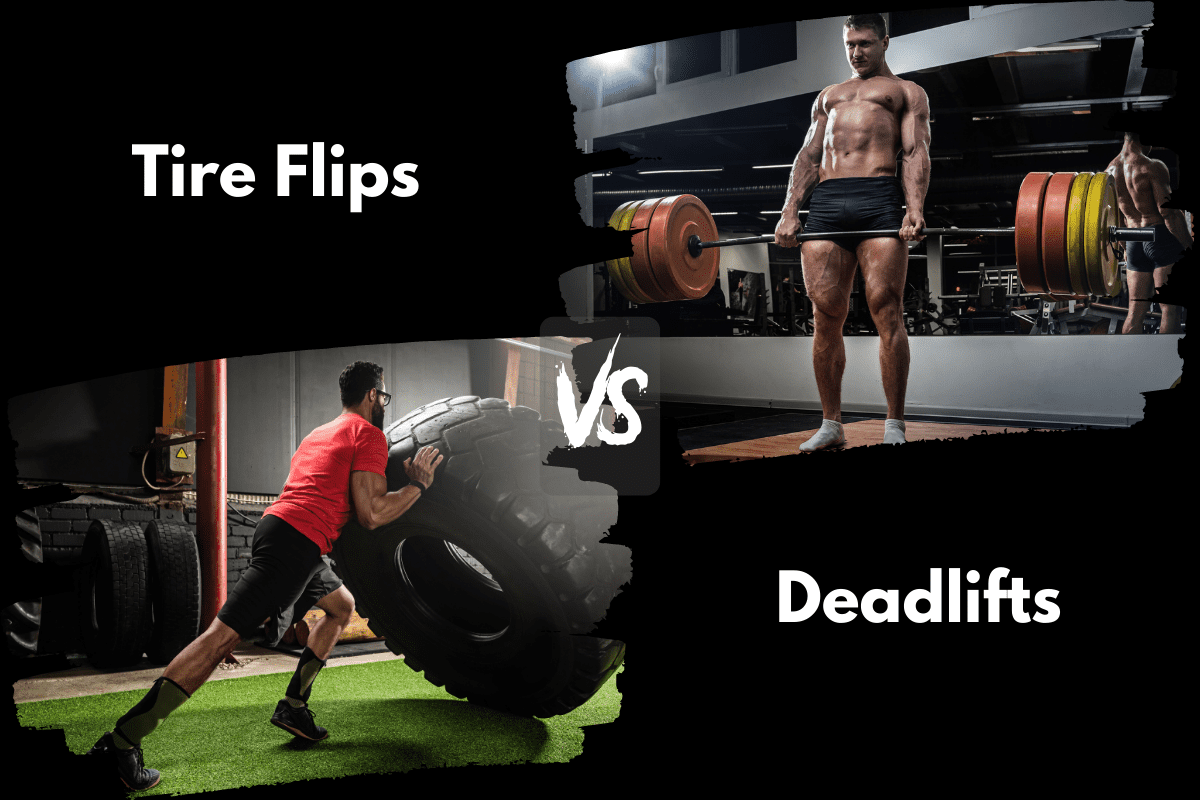Tire Flips vs Deadlift (Which is Better For Strength?)
Tire Flips and Deadlifts are two of the most popular strength and conditioning exercises widely used by athletes, weekend warriors, and bodybuilders. Both exercises have their unique benefits and drawbacks, and choosing between the two can be difficult.
Tire Flips is a full-body movement that requires explosive strength and power, while Deadlifts are a more targeted exercise that focuses on building strength in the lower back, legs, and glutes.
In this article, I will be comparing Tire Flips and Deadlifts, discussing their benefits, drawbacks, and when each exercise is best suited. I will also be providing tips and tricks to help you get the most out of each exercise. So, buckle up and get ready to learn everything you need to know about Tire Flips vs Deadlifts!
Tire Flips

Equipment Needed
- Tire
Muscles Worked
- Tire Flips are a true total body movement. Almost every major muscle group is at work at some point during Tire Flips.
How To
- Make sure you have plenty of space to be able to safely flip the tire.
- Start with the tire laying on the ground on its side.
- Stand with toes almost against the tire, feet roughly shoulder-width apart.
- Drop the hips and reach under the tire.
- Once you have a good grip under the tire flatten your back and brace your core.
- Drive the feet through the ground and aggressively begin to extend the hips.
- If the tire is heavy, you can slide one knee under the tire to help with leverage once the tire is high enough.
- When the tire gets above stomach height, flip your hands around so you can begin to push the tire.
- Push the tire forcefully forward – extending with both your arms and legs.
- The tire should land on its side. Repeat for the designated amount of distance or reps.
Coaching Points
The biggest key to Tire Flips is perhaps in finding the right tire.
Every school I’ve ever worked at had big tires that were used for Tire Flips. However, the size and weight of these tires have all been drastically different. They’ve ranged from tires that were barely heavy enough to be worth using to tires that took two and sometimes even three football players to flip.
Just like with Deadlifts and Power Clean, it’s extremely important to drop the hips, use the legs and keep the back flat. Once fatigue starts to set in I generally see athletes resort to using more back than legs. If form reaches this point then it’s time to stop flipping the tire.
Don’t have a giant tire and need a substitution? Here are my favorite Tire Flip alternatives.
Benefits of Tire Flips
Tire Flips can provide a ton of benefits including:
- Tire flipping is a total body movement, including the legs, back, arms, and core, providing a full-body workout in a single exercise.
- The intense nature of tire flipping can provide an excellent cardiovascular workout, which can help improve overall endurance and cardiovascular health.
- Tire flipping requires a significant amount of upper and lower body strength and explosiveness, making it an excellent exercise for developing overall strength and power.
- Tire Flips require a strong core to maintain proper form and stability throughout the movement, making it an effective exercise for improving core stability.
- Beyond the physical benefits, Tire Flips can be extremely mentally challenging as well, which can help improve mental toughness and resilience.
- Tire Flips can be a fun and different way to add variety to your workout routine, keeping it fresh and interesting.
Deadlift (Conventional)

Equipment Needed
- Barbell
- Bumper or Iron Plates
Step-by-Step Instructions
- Place feet roughly shoulder-width apart (The width of a stance for an athlete choosing a wide stance will vary based on height and comfortability).
- Slightly turn their feet outward (engaging the glutes).
- Take a deep breath to brace the abdominal muscles.
- The athlete should hinge at the waist and bend at the knee simultaneously until they can comfortably squeeze the barbell with both hands pronated (I will talk more later about mixed grips later).
- Hands should be roughly shoulder-width apart so that the arms are just outside of the legs.
- As the athlete pulls themselves down into their setup position, they should maintain a neutral head posture, with their eyes fixed on something about 1-2 feet in front of them.
- In the final setup position, the athlete should pull their chest up, and shoulder blades back, while still maintaining a brace in their abdominal muscles and ready to lift.
- The athlete needs to pull the “slack” out of the barbell. This is where the lifter needs to create tension by slightly pulling into the barbell and pushing their feet into the floor before maximal contraction/attempts.
- Once this tension is created, the lifter drives their feet through the floor, drives the hips forward, keeping tension in the abdomen and upper back (DO NOT ROUND YOUR BACK), maintaining the barbell over the midfoot, the lifter stands tall with the barbell, and locks the repetition in.
- After locking in the repetition for about 1 second, the athlete is ready to lower the weight. The athlete will take in a big breath, maintaining a braced core and shoulder blades pulled together. The hips will push back and the knees will bend simultaneously. (Or the bar can just be dropped)
Grip
Now, let’s talk about gripping the bar. For most field and court sports athletes, gripping the bar with an overhand grip is what I would recommend.
The main reason I recommend this grip is that the athlete is deadlifting to gain strength and athletes should be training symmetrically as much as possible. This is not to say that a mixed grip is bad for lifters. A mixed grip in some cases will help the lifter pull more weight. But again, I must stress, that lifting more weight for “more weight’s” sake is not a good reason.
Some lifters may switch which grips they mix (right-supinated, left pronated and vice versa) but this will be hard to track after hundreds of reps and sets over the course of a lifter’s career.
Obviously, a powerlifter will be training with the grip that they see that helps them pull the most weight.
Coaching Points
In regards to your setup and form; treat every rep like it’s a 1 rep max. Put a tremendous amount of detail in your setup (Do it the exact same way, every rep).
Make small gains in weight over time. Deadlifting is not a race.
Deadlift Benefits
Deadlifts are a type of strength training exercise that have a number of benefits. Some of the benefits of deadlifts include increased muscle mass and strength, improved posture and balance, and increased flexibility and range of motion in the hips and lower back.
Deadlifts can also help to improve overall athletic performance, as well as increase bone density and reduce the risk of injury.
Tire Flips vs Deadlifts: Which is Better?
Now, let’s compare the two exercises side-by-side to see if one is better than the other for some common lifting goals.
Better For Developing Size and Strength: Deadlifts
Let me start by saying both Tire Flips and Deadlifts are extremely effective for improving strength and building mass. I give the edge to Deadlifts though because of the versatility of being able to manipulate the volumes and intensities used.
For example, with Deadlifts, we can work one day at a moderate intensity, let’s say, 5 sets of 5 at 75% of our max. The following week we could work at a higher intensity (and lower volume) like 5 sets of 3 at 85%.
This manipulation of volume and intensity over the course of a strength program is known as periodization and, long term is going to lead to better overall gains in both strength and hypertrophy.
On the other hand, most of us are pretty likely to have access to one giant tire that we can use for Tire Flips, let alone an entire collection of different sizes and weights. In that regard, Tire Flips is a bit of a one-trick pony. It’s an amazing trick and I love it, but it’s not something you can really build a sustainable long-term program around.
Better For Beginners: Deadlifts
Both exercises require the same basic technical requirements. Lifters need to know how to use their hips (and not their back) to lift from the ground, how to set up with a good flat back and how to effectively brace their core.
Having said that, I think learning and knowing how to Deadlift should be the prerequisite for doing Tire Flips. Deadlifting is a much more controlled environment to learn proper form. And, we can start as light as necessary while we’re learning.
So, my suggestion would be to learn how to Deadlift first, then move on to Tire Flips when you’re ready.

Online Strength Programs
- 1-on-1 Online Coaching
- Sports Performance Programs for Football, Basketball, Soccer & More
- Programs for Former Athletes (Legends) Who Still Want to Train Like Athletes
- Programs for Adults Who Want to Get Healthy (and look great at the beach!)
- Use Code “HB10” to Get 10% Off Today
Final Thoughts
I just spent the last section of this article comparing which exercise is better, Tire Flips vs Deadlifts. The truth is, there is no reason (assuming you have the necessary equipment) that you shouldn’t have both movements as part of your strength and conditioning program.
Both are incredibly effective movements for building strength and power. And, incorporating both into your program can add some much-needed variety and keep your workouts from getting stale.
Related Posts
So, there’s no need to try to choose between the two. Instead, figure out how to properly utilize both Tire Flips and Deadlifts.

